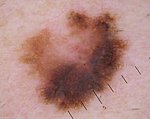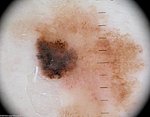Dermtest wants to improve early detection of melanoma
Melanoma is the most common form of skin cancer, which was diagnosed over 100.000 times in Europe and resulted in over 22.000 melanoma related death in 2012. But it doesn't have to be that way.
If detected early melanoma can be fully treated 97-99%. But as soon as the cancer develops through the deeper skin layers and starts spreading across the human organism it becomes very hard to cure melanoma and survival rate decreases to below 20%.
Melanoma usually evolves from birthmarks, which is why people should monitor any changes on their skin. Some kind of birthmarks are more prone to develop melanoma: dysplastic, abnormal and people born with giant birthmarks
If one or few of your birthmarks make you worry you should definitely consult with a specialist.
On this page you will learn:What melanoma looks like
Melanoma is a type of skin cancer, which starts from pigment cells, which are responsible for the colour of your skin and hair. Pigment cells with melanoma start spreading unnaturally, which results in non-typical moles but can also result in new birthmarks or naevus. This is why it is important to keep a close eye on all changes on your skins and consult a doctor if you find something suspicious
Below are some images of different cases of melanoma
Melanoma risk factors
Factors that may increase your risk of melanoma include::- Fair skin. Having less pigment (melanin) in your skin means you have less protection from damaging UV radiation. If you have blond or red hair, light-colored eyes, and freckle or sunburn easily, you're more likely to develop melanoma than is someone with a darker complexion. But melanoma can develop in people with darker complexions, including Hispanics and blacks.
- A history of sunburn. One or more severe, blistering sunburns can increase your risk of melanoma.
- Excessive ultraviolet (UV) light exposure. Exposure to UV radiation, which comes from the sun and from tanning lights and beds, can increase the risk of skin cancer, including melanoma.
- Living closer to the equator or at a higher elevation. People living closer to the earth's equator, where the sun's rays are more direct, experience higher amounts of UV radiation than do those living in higher latitudes. In addition, if you live at a high elevation, you're exposed to more UV radiation.
- Having many moles or unusual moles. Having more than 50 ordinary moles on your body indicates an increased risk of melanoma. Also, having an unusual type of mole increases the risk of melanoma. Known medically as dysplastic nevi, these tend to be larger than normal moles and have irregular borders and a mixture of colors.
- A family history of melanoma. If a close relative — such as a parent, child or sibling — has had melanoma, you have a greater chance of developing a melanoma, too.
- Weakened immune system. People with weakened immune systems, such as those who've undergone organ transplants, have an increased risk of skin cancer.
How to protect yourself?
- Wear Sunscreen. Make sunscreen a daily habit. UV radiation can still damage skin even in the winter and on cloudy days. Use broad-spectrum sunscreen (protects against UVA and UVB rays) with SPF of at least 30.
- Wear Protective Clothing. Protect your body with sun-protective clothing, hat, and sunglasses.
- Avoid Peak Rays. Seek shade during the mid-day sun, when the sun’s rays are most intense.
- Don’t Use Tanning Beds. Indoor tanning has been shown to increase the risk of melanoma by up to 75%. Melanoma is the number one new cancer diagnosed in young adults (ages 25-29), and scientists attribute this trend to the use of tanning beds among this age group, particularly young women.
- Protect Children. Just one bad sunburn in childhood or adolescence doubles your child’s chances of developing melanoma later in life.
Find the nearest clinic near you.
Sources:



